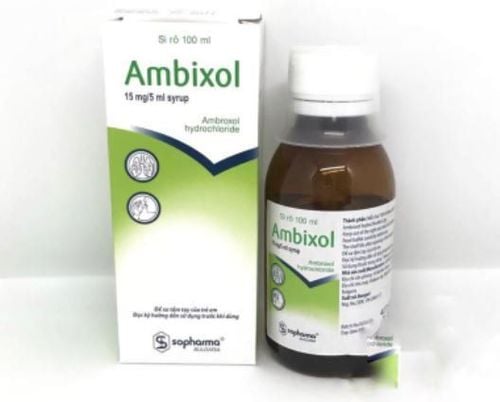This is an automatically translated article.
The article is professionally consulted by Master, Doctor Nguyen Huy Nhat - Department of Medical Examination & Internal Medicine - Vinmec Danang International General Hospital. Doctor Nguyen Huy Nhat has many years of experience in the field of respiratory disease treatment.Bronchitis is one of the most common inflammatory diseases of the respiratory tract in community life. The most common causative agent is a virus, but there are also many cases of bacterial infection. From there, the treatment and follow-up are also completely different. Therefore, it is necessary to be aware of the difference between viral bronchitis and bacterial bronchitis for early recognition, adherence to treatment and appropriate prevention.
1. What is bronchitis?
The bronchi are an anatomical structure of the lower respiratory tract. The inhaled air is passed through the nostrils as the first gateway, then the pharynx, larynx, trachea, and bronchi, respectively, before reaching each alveolar sac in the lung parenchyma. The bronchial system has a hierarchical structure like a tree root with 23 divisions. From there, the "bronchial tree" forms an interlaced network in the two lung fields, dividing the incoming air into very small parts, using efficient gas exchange with the environment outside the body.Bronchitis is an inflammatory condition that occurs in any segment of the bronchial tree system. If near the site of the first bifurcation, bronchitis may be accompanied by tracheitis or laryngitis. On the contrary, if bronchitis is at the end of the alveoli, it can cause bronchitis - bronchitis.

2. Distinguishing viral bronchitis and bacterial bronchitis
2.1 About pathogens The most basic difference between viral bronchitis and bacterial bronchitis is the causative agent.Of these, viruses are the cause of 60-70% of cases of bronchitis. Viruses that commonly cause disease are strains with affinity for the human upper respiratory tract such as respiratory syncytial, influenza, parainfluenza or adenovirus. They often cause outbreaks and seasonal diseases, the disease is usually mild, self-resolving without specific treatment.
In contrast, bacterial bronchitis is less common and is mainly due to further superinfection while resistance is weakened. In terms of epidemiological characteristics, bacterial bronchitis is still common in developing countries, with poor sanitation, low and unstable incomes like Vietnam. Common disease-causing bacteria such as pneumococcus, H. influenzae, staphylococcus, streptococcus, E.coli,...
In addition to the pathogens that cause bronchitis, which are bacteria, patients are also susceptible to this condition. when inhaling toxic vapors such as SO2, chlorine, ammonia, acids, industrial solvents,...
2.3 About disease manifestations Due to different pathogens, symptoms of viral bronchitis and bronchitis caused by viruses In general, bacteria also have many differences.
Symptoms of viral bronchitis:
Symptoms are often very vague according to a viral infection syndrome. Initially, the symptoms of upper respiratory tract infection were very intense, including coughing, sneezing, stuffy nose, watery eyes and nose, accompanied by headache, body aches, sore throat, hoarseness of voice. . Usually a dry cough or a cough with clear white sputum.
Epidemiologically, viral bronchitis is common during flu season or winter-spring weather changes. Family members or people around may also have similar symptoms, the speed of spread is very fast through inhalation or contact.
Symptoms of bacterial bronchitis
In addition to the symptoms of viral bronchitis similar to those above, patients with bacterial bronchitis also show an infection syndrome. Specifically, the patient has a dull, emaciated face, dry lips, dirty tongue, bad breath and may be accompanied by a high fever. Not only that, secretions in the respiratory tract cause the patient to cough up purulent sputum, cloudy sputum or yellow-green sputum; This is very different from the case of a viral infection, the patient often coughs dry or coughs with white sputum.
In addition, another difference between bacterial bronchitis and viral bronchitis is that this disease is completely incapable of remission on its own. Even if not treated aggressively at the beginning, the spread of bacteria or the acquisition of highly virulent bacteria, the infection can easily spread around, enter the bloodstream causing sepsis, multi-muscle failure. and sometimes life-threatening.

Since then, the treatment of the two conditions of bronchitis is also completely different. In the treatment of viral bronchitis, it is mainly supportive, symptomatic treatment such as fever reduction, pain relief and prevention of superinfection. Besides, patients are also encouraged to drink lots of water, eat more fruits to improve resistance. It should be noted that antibiotics are absolutely not indicated in cases of common viral bronchitis. Because the use of antibiotics in this case is not only unnecessary but also increases the rate of antibiotic resistance.
Meanwhile, for the treatment of bacterial bronchitis, in addition to the same treatment as viral bronchitis, the participation of antibiotics is imperative in controlling and destroying the bacteria. The antibiotic groups selected initially are beta-lactams or respiratory quinolones, with the dosage and number of times a day, the number of days that need to be strictly adhered to.
For cases of viral bronchitis with severe superinfection or initial infection with highly virulent strains, hospitalization is required for inpatient treatment with systemic antibiotics. Moreover, doctors also have the conditions to closely monitor the progression of the disease, take supportive treatment when necessary, to avoid complications.
However, the prevention of disease is generally more meaningful than treating the disease once it is acquired. Specifically, each person needs to actively build their own strong resistance. To do so, it is basic to have a scientific diet, rich in fresh fruits to provide many vitamins and minerals. Besides, pay attention to work, study and rest properly, have the habit of doing sports and exercising in moderation. In addition, we need to actively maintain good personal hygiene and protect the surrounding environment to be clean and fresh.
In summary, viral bronchitis and bacterial bronchitis have many differences, ranging from disease manifestations, treatment methods and subsequent prognosis. In any situation, it is necessary to actively visit the right specialist for early and proper treatment. However, the most important thing is to be proactive in preventing illness and protecting the health of yourself and other family members.
Please dial HOTLINE for more information or register for an appointment HERE. Download MyVinmec app to make appointments faster and to manage your bookings easily.














